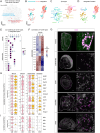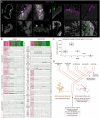This is a preprint.
Evolution of Cajal-Retzius Cells in Vertebrates from an Ancient Class of Tp73+ Neurons
- PMID: 40894618
- PMCID: PMC12393536
- DOI: 10.1101/2025.08.21.671508
Evolution of Cajal-Retzius Cells in Vertebrates from an Ancient Class of Tp73+ Neurons
Abstract
In the developing cerebral cortex, Cajal Retzius (CR) cells are early-born neurons that orchestrate the development of mammalian-specific cortical features. However, this cell type has not been conclusively identified in non-mammalian species. Here we studied neurons expressing Tp73, a transcription factor specifically expressed in most mammalian CR cells. Comparisons of chicken, salamander, zebrafish, and little skate data indicate that Tp73-expressing neurons have conserved spatial distribution and transcriptomic signatures in vertebrates. Among the conserved Tp73-expressing cell types we find CR cells andTp73+ external tufted cells (ETCs) in the olfactory bulb of jawed vertebrates. ETCs and CR cells share the expression of most "canonical" CR cell transcription factors, such as Tp73, Lhx1, Lhx5, Ebf3, and Nr2f2, indicating that they are sister cell types. Our findings suggest that CR and ETCs evolved in stem vertebrates from cells involved in olfactory processing, with CR cells progressively acquiring new specialized roles in developmental signaling.
Figures





Similar articles
-
Prescription of Controlled Substances: Benefits and Risks.2025 Jul 6. In: StatPearls [Internet]. Treasure Island (FL): StatPearls Publishing; 2025 Jan–. 2025 Jul 6. In: StatPearls [Internet]. Treasure Island (FL): StatPearls Publishing; 2025 Jan–. PMID: 30726003 Free Books & Documents.
-
Short-Term Memory Impairment.2024 Jun 8. In: StatPearls [Internet]. Treasure Island (FL): StatPearls Publishing; 2025 Jan–. 2024 Jun 8. In: StatPearls [Internet]. Treasure Island (FL): StatPearls Publishing; 2025 Jan–. PMID: 31424720 Free Books & Documents.
-
The Black Book of Psychotropic Dosing and Monitoring.Psychopharmacol Bull. 2024 Jul 8;54(3):8-59. Psychopharmacol Bull. 2024. PMID: 38993656 Free PMC article. Review.
-
Signs and symptoms to determine if a patient presenting in primary care or hospital outpatient settings has COVID-19.Cochrane Database Syst Rev. 2022 May 20;5(5):CD013665. doi: 10.1002/14651858.CD013665.pub3. Cochrane Database Syst Rev. 2022. PMID: 35593186 Free PMC article.
-
Antidepressants for pain management in adults with chronic pain: a network meta-analysis.Health Technol Assess. 2024 Oct;28(62):1-155. doi: 10.3310/MKRT2948. Health Technol Assess. 2024. PMID: 39367772 Free PMC article.
References
-
- Goffinet A. M., The evolution of cortical development: the synapsid-diapsid divergence. Development 144, 4061–4077 (2017). - PubMed
-
- Elorriaga V., Pierani A., Causeret F., Cajal-retzius cells: Recent advances in identity and function. Curr. Opin. Neurobiol. 79, 102686 (2023). - PubMed
-
- Kirischuk S., Luhmann H. J., Kilb W., Cajal-Retzius cells: update on structural and functional properties of these mystic neurons that bridged the 20th century. Neuroscience 275, 33–46 (2014). - PubMed
-
- Causeret F., Moreau M. X., Pierani A., Blanquie O., The multiple facets of Cajal-Retzius neurons. Development 148, dev199409 (2021). - PubMed
Publication types
LinkOut - more resources
Full Text Sources
